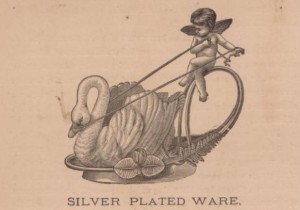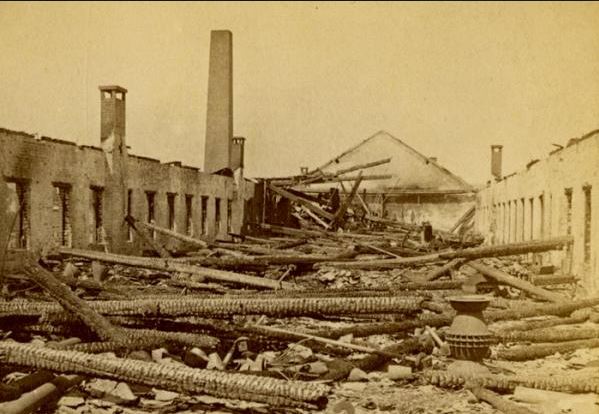By Nancy Finlay

Cupid and Swan Dish manufactured by the Meriden Britannia Company. Wood engraving by Asher & Adams, ca. 1876. An example of the ornate wares produced by Meriden Britannia during the 1870s – Connecticut Historical Society
On July 16, 1870, a devastating fire destroyed the main building of the Meriden Britannia Company, an internationally famed producer of silver-plated ware, in Meriden, Connecticut. The 700-foot-long building employed over 900 people, including 100 women, all of whom were left temporarily without work. However, the building was fully insured, the loss was fully covered, and rebuilding began immediately, while work continued unabated at the company’s six other factories. Although this was the worst fire ever to occur in Meriden, the building was back in production within months, with employees working up to 13 hours per day.

Manufactory of Meriden Britannia Company, West Meriden, Conn. Wood engraving by Asher & Adams, ca. 1876. This birds-eye view shows the factory as rebuilt – Connecticut Historical Society
Meriden Britannia took its name from Britannia metal, which is made of tin, copper, and antimony (an element with a silvery appearance). The company used this alloy as the base metal for its silver-plated household goods. These included elaborate goblets, pitchers, teas sets, cake baskets, candy dishes, vases, and epergnes, as well as more practical and functional flatware. (Epergnes are table centerpieces with tiered arms for holding food or flowers.) Though often overly ornate for modern tastes, these items gave designers and craftsmen plentiful opportunities to demonstrate their skill. Products of the Meriden Britannia Company received premiums at the American Institute Fairs in 1873, 1874, and 1875, and at the Philadelphia Centennial Exhibition in 1876. The American Institute pronounced its goods to be “By far The Best made in this country, and we believe in the world.”
Meriden Britannia continued to prosper until 1898, when it became part of the International Silver Company. International Silver became the largest producer of silver goods in the United States and Meriden became known as “The Silver City.”
Nancy Finlay, formerly Curator of Graphics at the Connecticut Historical Society, is the editor of Picturing Victorian America: Prints by the Kellogg Brothers of Hartford, Connecticut, 1830-1880.
© Connecticut Public Broadcasting Network and Connecticut Historical Society. All rights reserved. This article originally appeared on Connecticut History | WNPR News
Note: ConnecticutHistory.org does not edit content originally published on another platform and therefore does not update any instances of outdated content or language.









